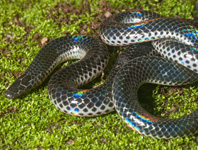Abstract
A new species of the uropeltid snake genus, Melanophidium Günther, 1864 is described based on a series of eight specimens. Melanophidium khairei sp. nov. is the fourth species described in the genus, and the first for 144 years. Superficially M. khairei sp. nov. resembles M. punctatum Beddome, 1871 in being piebald and punctate (and it was previously misidentified as M. punctatum), but in many scalation characters it more closely resembles M. wynaudense (Beddome, 1863). The new species occurs in southern Maharashtra, Goa, and northern Karnataka, in the Western Ghats region of peninsula India. It is the most northerly member of its genus. Lectotypes and paralectotypes are designated for M. wynaudense, M. bilineatum Beddome, 1870, and M. punctatum. A new key to the species of Melanophidium is presented. Aspects of the morphology, taxonomy and distribution of the three previously described species of Melanophidium are reviewed and revised.
References
Boulenger, G.A. (1893) Catalogue of the snakes in the British Museum (Natural History). Vol. 1. containing the families Typhlopidae, Glauconidae, Boidae, Ilysidae, Uropeltidae, Xenopeltidae and Colubridae aglyphae, part. British Museum (Natural History), London, xiv + 448 pp.
Cundall, D. & Irish, F.J. (2008) The snake skull. In: Gans, C., Gaunt, A.S. & Adler, K. (Eds.), Biology of the Reptilia. Vol. 20. Morphology H: the skull of Lepidosauria. Society for the Study of Amphibians and Reptiles, Ithaca, New York, pp. 349–692.
Dowling, H.G. (1951) A proposed method of expressing scale reductions in snakes. Copeia, 1951, 131–134.
http://dx.doi.org/10.2307/1437542Ganesh, S.R., Chandramouli, S.R., Sreekar, R. & Shankar, P.G. (2013) Reptiles of the central Western Ghats, India—a reappraisal and revised checklist, with emphasis on the Agumbe Plateau. Russian Journal of Herpetology, 20, 181–189.
Gans C. (1966) List und der rezenten Reptilian Amphibian. Uropeltidae. Das Tierreich, 84, 1–29.
Ghate, H.V. & Yazdani, G.M. (1991) First record of the pied-belly uropelt Melanophidium punctatum Beddome (Serpentes: Uropeltidae) from Maharashtra. Journal of the Bombay Natural History Society, 87, 463.
Gower, D.J. (2003) Scale microornamentation in uropeltid snakes. Journal of Morphology, 258, 249–268.
http://dx.doi.org/10.1002/jmor.10147Gower, D.J., Captain, A. & Thakur, S.S. (2008) On the taxonomic status of Uropeltis bicatenata (Günther) (Reptilia: Serpentes: Uropeltidae). Hamadryad, 33, 64–82.
Gower, D.J. & Ablett, J.D. (2006) Counting ventral scales in Asian anilioid snakes. Herpetological Journal, 16, 259–263.
Gower, D.J. & Maduwage, K. (2011) Two new species of Rhinophis Hemprich (Serpentes: Uropeltidae) from Sri Lanka. Zootaxa, 2881, 51–68.
Günther, A.C.L.G. (1875) Second report on collections of Indian reptiles obtained by the British Museum. Proceedings of the Zoological Society of London, 43 (1), 224–234.
Irfan-Ullah, M. & Davande, S. (2008) Western Ghats Ecogeographic boundary as developed from physiographic and biogeographic data. Available from: http://indiabiodiversity.org/map? layers=lyr_7_wg_boundary&title=WGBoundary (accessed 4 May 2015)
Khaire, N. (2006) A guide to the snakes of Maharashtra, Goa and Karnataka. Indian Herpetological Society, Pune, 129 pp.
Mahendra, R.C. (1984) Handbook of the snakes of India, Ceylon, Burma, Bangladesh, and Pakistan. Annals of Zoology, 22, 1–412.
McDiarmid, R.W., Campbell, J.A. & Touré, T. (1999) Snake Species of the World. A Taxonomic and Geographic Reference. Vol. 1. The Herpetologists’ League, Washington, 511 pp.
Molur, S. & Walker, S. (1998) Conservation Assessment and Management Plan Workshops report. Reptiles of India. Zoo Outreach Organisation, Coimbatore, 62 pp.
Murthy, T.S.N. (1982) An illustrated field guide to the rough tailed snakes of India. The Snake, 14, 119–135.
Olori, J.C. & Bell, C.J. (2012) Comparative skull morphology of uropeltid snakes (Alethinophidia: Uropeltidae) with special reference to disarticulated elements and variation. PLoS ONE, 7 (3), e32450.
http://dx.doi.org/10.1371/journal.pone.0032450Rieppel, O. & Zaher, H. (2002) The skull of the Uropeltinae (Reptilia, Serpentes), with special reference to the otico-occipital region. Bulletin of the Natural History Museum, London (Zoology), 68, 123–130.
http://dx.doi.org/10.1017/s0968047002000146Sharma, R.G. (2003) Handbook—Indian snakes. Zoological Survey of India, Kolkata, xx + 292 pp.
Smith, M.A. (1943) The Fauna of British India, Ceylon and Burma, Including the whole of the Indo-Chinese sub-region. Reptilia and Amphibia. Vol. 3. (Serpentes). Taylor and Francis, London, 583 pp.
Srinivasulu, C., Srinivasulu, B., Ganesan, S.R., Kulkarni, N.U., Sreekar, R. & Prabhu, M. (2013) Melanophidium punctatum. The IUCN Red List of Threatened Species. Version 2014.3. http://www.iucnredlist.org (accessed 2 January 2015)
Vijayakumar, S.P., Vasudevan, K. & Ishwar, N.M. (2001) Herpetological mortality on roads of the Anamalai Hills, southern Western Ghats. Hamadryad, 26, 265–272.
Whitaker, R & Captain, A. (2004) Snakes of India, the field guide. Draco Books, Chennai, xiv + 481 pp.

